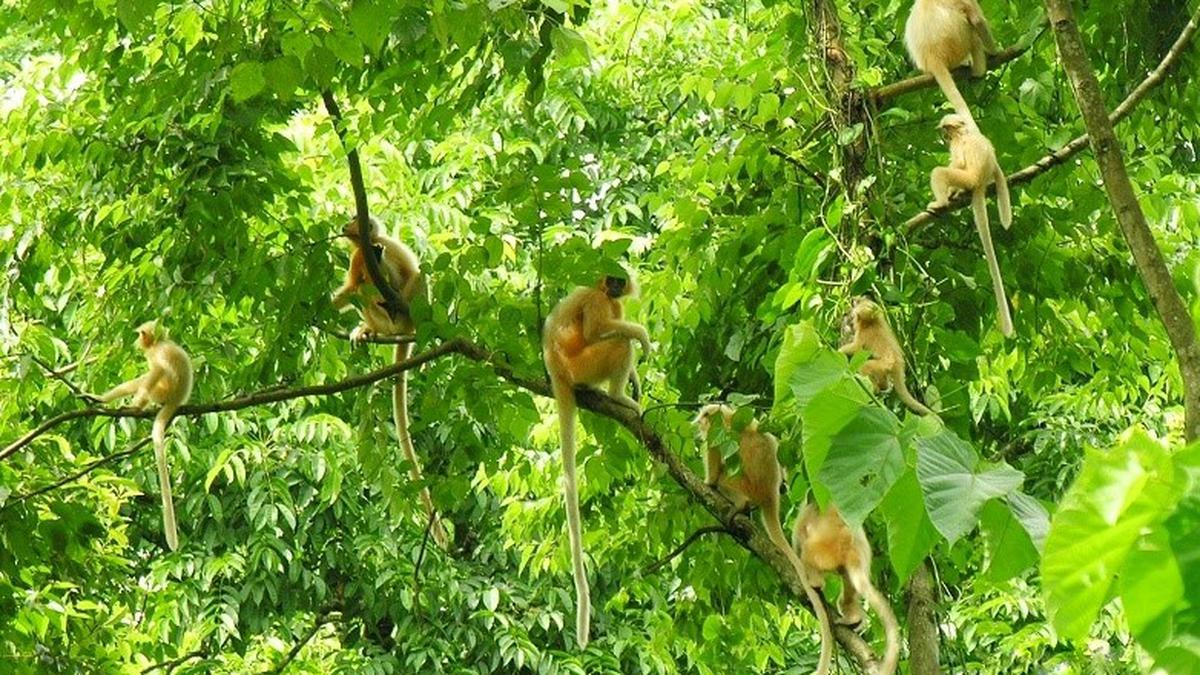GUWAHATI
There are an estimated 7,396 golden langurs in India, the latest survey of the primate has revealed. The comprehensive population estimation of the endangered primate was carried out in two phases by the Primate Research Centre NE India (PRCNE), Assam Forest Department, Bodoland Territorial Council, Salim Ali Centre for Ornithology and Natural History (SACON), and Conservation Himalayas.
The entire distribution range of the golden langur (Trachypithecus geei) covers the Manas Biosphere Reserve and all fragmented forests in the western part of Assam.
In the first phase during March-April 2020, the survey covered the western part of the Manas Biosphere Reserve, including Ripu Reserved Forest — a major part of it was recently upgraded to Raimona National Park – Chirang Reserve Forest, Manas Reserve Forest, and Manas National Park up to the western bank of the Manas River.
The second phase during the same months in 2021 focussed on fragmented forest habitats of golden langurs in the Bongaigaon, Kokrajhar, and Dhubri districts of western Assam. The block count method was applied for the first time to assess the abundance, spatial distribution, and densities of the golden langur populations.
“This method is considered to be relatively simple, cost-effective, and robust for arboreal and small group-living primates such as the golden langur,” H.N. Kumara, the principal scientist of SACON said.
The golden langur habitat was demarcated into 51 counting blocks, each overlaid with 50-hectare grid cells. Ten teams, each comprising one or two trained enumerators and three to four forest staff, surveyed the blocks.
“We observed 7,720 individuals of golden langurs in 706 unique groups and 31 lone males or floating males. Estimating minimum population size, we found there to be 7,396 individuals in 707 groups, inclusive of bisexual and male bands, along with 31 lone males,” Jihosuo Biswas, the lead primatologist at PRCNE said. He supervised the survey.
Threat to fragmented populations
“The population of golden langurs is divided into two major sub-populations. The northern extended population, which encompasses the western part of the Manas Biosphere Reserve, extending from the Sankosh River to the Manas River up to the India-Bhutan border along the northern side of National Highway 27 and State Highway 2,” Dr. Biswas explained.
“The southern fragmented population occurs along the southern side of NH27 up to the Brahmaputra River in the south,” he said.
The northern population of the primate with the golden sheen was estimated at 5,566 in 534 groups and 23 lone males. The population of the southern fragments was estimated at 1,830 langurs in 173 groups and eight lone males.
While the Ripu Reserve Forest was home to the most (2,847) northern population golden langurs, Kokrajhar district’s Chakrashila Wildlife Sanctuary had 838 individuals, the most in the southern fragmented range of the primate.
The previous population estimation in 2008-09, also conducted under the supervision of Dr. Biswas, recorded 6,000 golden langurs in India. Each group then had has average of 9.24 individuals, which was 1,45 individuals less than the average group recorded in the latest survey.
On the flip side, the survey report underlined an unstable situation in the fragmented habitats of the golden langurs, particularly due to the absence of non-breeding all-male bands. The primatologists involved in the survey highlighted the need for corridor linkage among the fragmented habitats through plantations and canopy bridges to offset potential threats the primates face from anthropogenic interactions.
